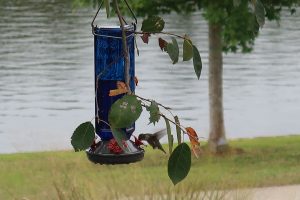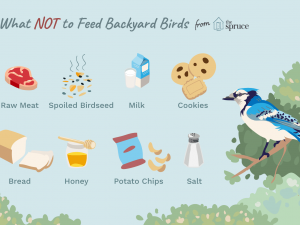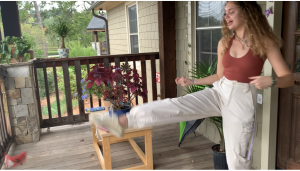By Emma Johnston
It occurred to me recently that I kind of like being in small spaces. I grew up sleeping in a “Privacy Pop” (sometimes under a weighted blanket), and have this tendency to curl my limbs in tight to my body whenever the situation (and seating) allow it. I don’t know that I’d go so far as to say I’m a claustrophiliac. I certainly prefer soothing compression over strict confinement. But it got me thinking…

…we were staring at the exterior of a refurbished 1969 Lamar vintage camper at the Swamp Rabbit Inn in Travelers Rest. My mom was in town to deliver a “new” used bike, and we took it – and my old cruiser – for a ride on the trail. She had stumbled upon a listing for the camper the week before, and arranged to see it in person. Absorbing what 17 feet by 7 feet by 8 feet looks like in real life, we gushed at how precious it was; like, theoretically, how adorable it would be for someone else to inhabit it – perhaps a doll-sized person. But as soon as we stepped inside, I became completely captivated with the idea of downsizing to “camper living.”
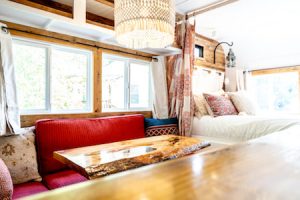
The interior was stunning, which you wouldn’t (or, at least, I didn’t) necessarily expect from a trailer. A macrame chandelier hanging over a live edge dining table. A beautiful copper bathroom sink. A bohemian-style queen bed under a panoramic window. And a layout so smart, you wouldn’t even believe you’re looking at less than 100 square feet of space. Not to mention all of the amenities you could ever need: heating and air conditioning, electrical outlets, cable TV, high speed wifi, and a full kitchen! What dawned on me during this tour – which basically amounted to turning 360 degrees – was how much someone could genuinely love living here. Sure, there are the prudent reasons for downsized living: the minimalist lifestyle, money-saving benefits, mobility and, perhaps most importantly, environmental friendliness. But I’d figured that, in the transition, the emphasis would be on what had to be given up in the transition. Inside that perfectly-appointed little Lamar, however, was not a vibe of sacrifice but of refinement, dignity, and comfort.
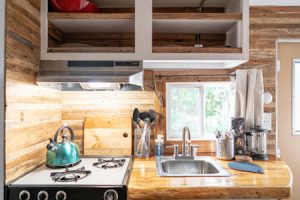
Although downsizing or tiny living is becoming increasingly popular, the average American residence continues to increase in size. The average American home has swelled by 140% from the typical 1,000 square feet in 1950. During the recession of 2008, Americans began to downsize, citing economic or environmental reasons. But this phenomenon was woefully short-lived. Now, it seems as with so many aspects of American life, there are increasingly polar opposites: those seeking to live larger and more opulent, and those looking to clean out and scale back. There is, of course, evidence that Mother Earth favors the latter.
Perhaps the greatest sustainable outcome of the switch to tiny living is the reduction of carbon emissions. Out of electricity, natural gas, and heating oil, electricity uses up the most energy in American households, making up 53% of the energy used in an average American home. According to Timothy Carlin, author of the article “Tiny Homes: Improving Carbon Footprint and the American Lifestyle on a Large Scale,” the production of electrical energy also primarily relies on coal as fuel, creating 241.6 million metric tons of carbon emissions. This amount of carbon waste would fill 15,100,000 dump trucks. On the individual level, the average American carbon footprint is more than 28.5 tons of carbon emissions per year, with about 2.72 tons produced from electrical energy.
So, how does camper living decrease carbon emissions? Clearly a camper comprises a much smaller space than the average American home, requiring less electrical energy to run compact appliances, provide temperature control, and provide lighting. In fact, natural daylight can illuminate nearly the entire space. In addition, campers require minimal natural gas for heating and cooking. Not only do campers cut back on carbon emissions, but they also save water with composting toilets. This is the most common type of toilet in a camper, as these structures are not connected to a pre-existing septic system. Composting toilets reduce household water usage by up to 60%, reduce marine pollution, and oftentimes, the waste is recycled into the environment as fertilizer, creating more productive and fertile soil.
Aside from these measurable, directly-sustainable benefits of camper living, there are other advantages that may not be as apparent. With the necessity of downsizing comes picking out only the most essential belongings, from clothing and keepsakes to kitchen goods and cleaning supplies. Intentionally eliminating unnecessary items that don’t actively serve a purpose in everyday life is the mentality needed for camper living. This minimalist mindset – enforced by limited camper storage – decreases consumer waste; you simply don’t have the physical room for the purchase of unnecessary items, so you don’t have the mental room for constant upgrade and replacement, either. This, blissfully, produces a feeling of control over – and settled satisfaction in – one’s life.
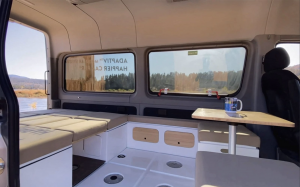
Back on campus, I pondered how I could really make that lifestyle a reality someday. There’s the option of purchasing an old camper and refurbishing it, like the folks at the Swamp Rabbit Inn. I also discovered a company called Happier Camper, which offers flex-designed trailers for downsizers concerned more with function and flexibility over aesthetics and repurposing. Happier Camper also offers an “Adaptiv” line of block-in-grib components for existing camper- or van-owners. These modular interior pieces allow for complete customization of the layout of just about any size trailer or campervan.
Consider how it would feel to truly love every square foot and every single feature of your home – from gorgeous flooring to awesome appliances to the perfect mattress – because being scaled way down makes it much more affordable. You can feel savvy and righteous in your eco-friendly lifestyle, but you can also genuinely enjoy how every single charming nook and cranny hugging you in serves a purpose. Turns out I’ll take a hug from a nook or cranny anytime, anywhere – maybe someday everytime, everywhere.
Sources:
“Adaptiv™ System.” Happier Camper, Happier Camper, happiercamper.com/pages/adaptiv%E2%84%A2-for-campers.
Carlin, Timothy. “Tiny Homes: Improving Carbon Footprint and the American Lifestyle on a Large Scale.” Celebrating Scholarship and Creativity Day, College of Saint Benedict, 24 Apr. 2014.
“Stay in Travelers Rest With Lola The Glamper Camper.” Swamp Rabbit Inn, Swamp Rabbit Inn LLC, 19 Oct. 2018, www.swamprabbitinn.com/blog/2018/10/11/go-glamping-with-lola-the-vintage-camper.
“To Flush Or Not To Flush: The Truth About Composting Toilets.” The American Home Shield, American Home Shield Corporation, www.ahs.com/home-matters/cost-savers/the-truth-about-compost-toilets/.
“1969 Lamar.” Vintage Camper Trailers, 4 Jan. 2019, www.vintagecampertrailers.com/for-sale/1969-lamar.



